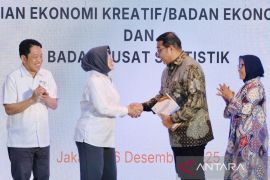They are Buleleng district for its craft sub-sector; Garut district for its performing arts sub-sector; Grobogan district, culinary sub-sector; Karawang district, performing arts sub-sector; South Jakarta city, fine arts sub-sector; and Yogyakarta city, fine arts sub-sector.
The ministry's main expert for tourism and creative economy, Nia Niscaya, said here on Tuesday that the Creative KaTa program aims to explore, utilize, and foster the excellent creative economy of regions.
It also seeks to build stakeholders' awareness and commitment so that a conducive ecosystem for the development of creative districts and cities can be created.
The selections for Creative KaTa were carried out on August 1–13, 2024, based on submissions of forms, profile videos, and presentations on the situation of the creative economy ecosystem in the regions.
Director for creative economy infrastructure at the ministry, Oneng Setya Harini, said that the ministry is ensuring that Creative KaTa remains sustainable and is not merely about status and recognition.
"The ministry is also providing guidance through several follow-up programs, such as creating a road map for the development of Creative Districts and Cities," she informed.
Furthermore, she said, the ministry has built synergy to improve the capacity and provide certification to creative economy players as well as bolstered networks with stakeholders for the creative economy in districts and cities.
Harini informed that in terms of infrastructure development, the Ministry of Tourism and Creative Economy has implemented several schemes, including the Tourist Destination Creation Center with special allocation funds and Government Assistance Tasks in the form of creative economy facilities.
Meanwhile, deputy chair of the 2024 Creative KaTa development program assessment team, Luhur Fajar Martha, said that the "creative economy ecosystem" was the keyword emphasized in the 2024 assessment.
He noted that the Creative KaTa assessment process this year was not easy because each participant had a different cultural, economic, and social background, yet the assessors had to maintain objective evaluation standards.
The goal was to build the development of a creative economy ecosystem, not only for regions, but also to encourage creative districts and cities to contribute to the development of the national creative economy.
Related news: National Sports Week as tool to promote North Sumatra's tourism, MSMEs
Related news: Indonesia-Poland ministers discuss game industry development
Related news: Indonesia highly values safety in tourism sector: Sandiaga Uno
Translator: Sinta Ambarwati, Raka Adji
Editor: Azis Kurmala
Copyright © ANTARA 2024












